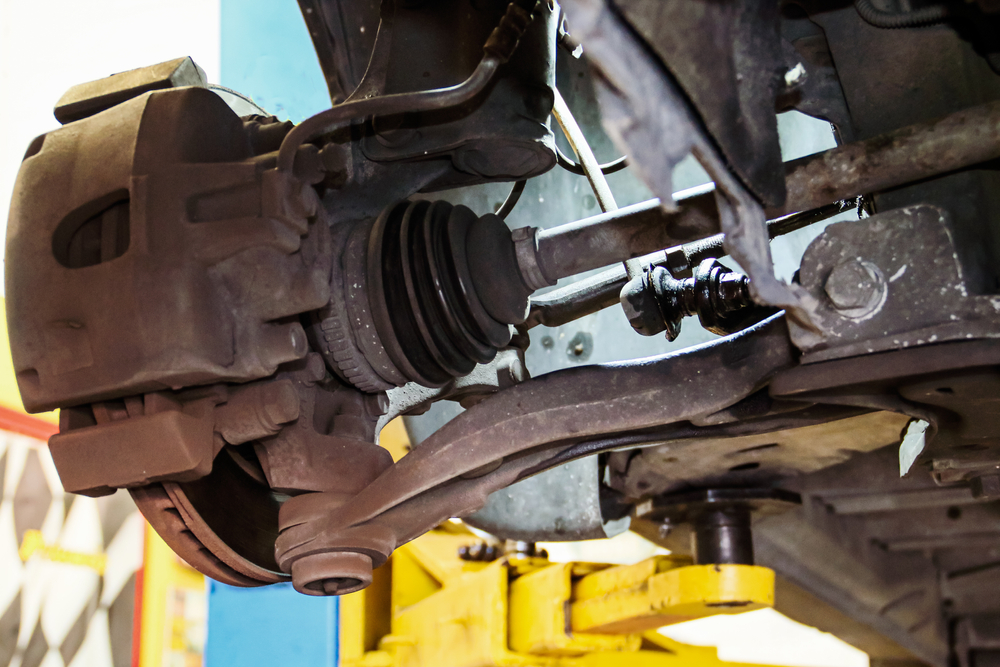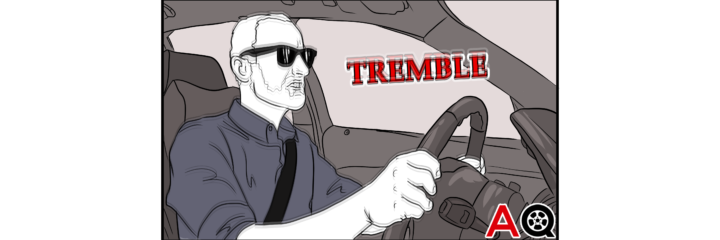You merge onto the freeway, and seeing nothing but open road before you, you step on the gas. Suddenly, your car starts to shake — and you think, “Finally! I’m finally doing it! I’m driving so fast that my ‘93 Celica is actually going to launch into orbit!”
Unfortunately, it’s extremely rare to convince an old jalopy to slip the surly bonds of Earth and enter the atmosphere. It’s much more likely that all that vibration is a sign that something’s wrong with your car.
Your car definitely isn’t supposed to shudder and shake every time you give it some gas, so don’t ignore this issue. It may be something simple and easy to fix, but if you let it go long enough, it can snowball into something far worse.
11 Reasons Why Your Car Vibrates While Accelerating
Below, we’ve compiled a list of the 11 most common reasons why your car might vibrate while accelerating — and what to do about them. Please note, however, that this list only covers shaking while accelerating; shaking while decelerating is an entirely different issue altogether.
1. Your Tires Aren’t Balanced
Unbalanced tires are one of the most common reasons why a car will shake, and it will often happen right after getting new tires or having them rotated.
If your tires aren’t balanced, they’ll wobble once the car’s in motion. The faster you go, the more they’ll wobble — and the more vibration you’ll experience as a result. At high speeds, the steering wheel may even shake.
The good news about this issue is that it’s incredibly easy and inexpensive to fix. Simply take your car into the shop and ask them to balance the tires for you. The place that sold you your tires will likely even do it for free.
2. Loose Lug Nuts
If your lug nuts aren’t securely fastened, the wheel is going to slide and shake while you drive. This will throw the entire car out of whack, causing some intense vibrations.
The longer you drive with loose lug nuts, the looser they’ll get, as the vibration will cause the nuts to rattle off their threads. Eventually, they’ll fall off — and your tire might follow.
If you’ve ever seen a gladiator movie with a chariot race, then you know having a wheel fall off at high speeds usually doesn’t end well for anyone involved. Fortunately, this is the easiest problem to solve, as all you have to do is take a lug wrench and tighten those nuts.
You should also check to make sure that your lug nuts are tight after every tire change.
3. Damaged CV Joint
If you have a front-wheel-drive car, then you’ll find a pair of constant velocity (CV) joints at the end of the driveshaft. The inner CV joints connect the driveshaft to the transmission, while the outer CV joints connect the driveshaft to the wheels.
These joints transfer torque from the transmission to the wheels at a constant speed (hence the name). This is important because you don’t want your wheels to start spinning at different velocities if you hit a pothole or make a turn.
If the inner CV joint starts to go bad, it will cause vibration to occur while accelerating. The more damaged the CV joint becomes, the worse the shaking will be. Don’t ignore this problem, because if the damage becomes too severe, you could do serious damage to your axle.
Unfortunately, replacing a damaged CV joint isn’t cheap — it can cost upwards of $1,000 in some cases. Still, it’s much cheaper to replace the joint than your entire axle.
4. Bent Driveshaft
While CV joints might be the culprit on front-wheel-drive cars, the driveshaft may be the issue on rear-wheel-drive models. The driveshaft functions much the same way as CV joints, as it transfers torque from the transmission to the wheels.
Driveshafts are very particular pieces of equipment, and they’ve been finely calibrated to transfer a precise amount of torque at various speeds. Thus, any damage to the driveshaft can have a huge impact on how your car handles.
A bent driveshaft will create quite a bit of vibration even at low speeds, and at high speeds the vibration could become nearly unbearable. You should get the problem addressed as soon as possible, because a damaged driveshaft can harm the other components in your drivetrain.
This is another expensive repair, as it usually costs between $500 and $1,000 to fix.
5. Bent Axle

It happens to the best of us: you hit a curb or a rock while driving, or maybe you get nailed by a red turtle shell fired at you by a jealous friend. You get out to inspect your car, but don’t notice any damage.
However, once you start driving again, you notice that the car vibrates intensely whenever you hit the gas. We hate to be the bearer of bad news, but chances are you just bent your axle.
As with driveshaft issues, vibrations caused by a bent axle will get worse the faster you go. Your car will also usually start pulling to one side, become very noisy, and leak grease.
You shouldn’t drive your car if you suspect you have a bent axle. Not only is it dangerous, but it could do a lot more damage, including breaking your CV joints and driveshaft.
As you might expect, replacing a broken axle is expensive. Plan on ponying up at least $500 to get the job done (and watch out for those turtle shells from now on, especially on that Rainbow Road).
6. Faulty Brake Calipers
In a disc brake system, the calipers act like clamps, stopping the wheel’s rotor from spinning whenever you hit the brakes.
If the calipers become broken or damaged, though, the rotor may start to stick. This will impede the car’s motion even when you’re not hitting the brakes. It won’t be enough to stop your car or even slow it down, but it will cause some serious shaking.
It’s fairly easy to figure out which caliper is causing the issue — all you have to do is act like Toucan Sam and follow your nose. There should be a distinct burning smell and possibly even smoke from the offending tire.
You may be able to solve the problem by cleaning and re-lubricating the caliper, but if that doesn’t work, you’ll need to replace it. And this will probably come as no surprise, but this isn’t a cheap repair. Expect to pay between $500 and $800 for a new caliper.
7. Bad U-Joint
U-joints (short for “universal joints”) connect the driveshaft to the differential on rear-wheel-drive vehicles, and they may also connect two driveshafts to one another or a driveshaft to your transmission. It looks like a little cross, and it lets the driveshaft move from side to side.
Your differential is what allows your wheels to spin at different speeds (like when you’re turning, for example). However, it doesn’t always stay aligned with your transmission, and the U-joint compensates for any differences. This allows your driveshaft to spin freely without becoming disconnected.
If the U-joint starts to go bad, though, the driveshaft will start to move outside of its normal path. This causes an imbalance, which in turn creates vibration at higher speeds.
A bad U-joint will sound a lot like an unbalanced wheel, except the sound will be at a much higher frequency since the driveshaft turns faster than the wheels do. It’s not something you should ignore, because a broken U-joint will eventually damage your driveshaft and transmission.
Replacing a U-joint isn’t quite as expensive as some of the other repairs on this list, but you should still expect to fork over somewhere between $200 and $500 to get the job done.
8. Busted Motor Mounts
As the name suggests, motor mounts are bits of hard rubber that keep the engine attached to the frame of the vehicle. They’re also designed to help absorb vibrations, creating a smoother, quieter ride.
You may not be a mechanic, but you can probably guess what happens when the part that’s designed to reduce vibrations goes bad.
It doesn’t take a brilliant engineer to understand that it’s a bad thing if the part that holds your engine in place breaks. Typically, you’ll want your engine to stay put when you’re driving (and even when you’re not).
If your car has a damaged motor mount, it should vibrate and shudder even if you’re idling. However, the vibrations should become much more pronounced the faster you go.
A broken motor mount can cause other parts to break or become misaligned, which can create a veritable cornucopia of engine problems, so it’s important to get it repaired as soon as possible.
Replacing a motor mount usually costs between $200 and $500, which seems like a lot for such a small, simple part. However, replacing one is something of an involved job, so labor costs are generally what make the repair so expensive.
9. Disconnected or Damaged Vacuum Hose
Your car’s engine is filled with vacuum hoses, which are flexible rubber lines that power everything from your windshield wiper motor to your cruise control. However, the hoses you’re most concerned with are the ones on your intake manifold.
The hoses on the intake manifold help create a vacuum that pushes fuel and air through the engine. If these hoses become loose or broken, excess air can enter the system, causing the car to vibrate, misfire, and idle roughly.
You may be able to spot the problem yourself, and it may be a simple issue to fix as well. However, some vacuum leak issues are quite complex, so if you want a pro to do the work instead, expect to pay anywhere from $150 to $1,000.
Why such a wide range? It all depends on where the leak is located and how severe it is.
10. Dirty or Damaged Spark Plugs
To understand what your spark plugs do, you first need to understand the cycles of an internal combustion engine.
There are four strokes in an internal combustion engine: intake, compression, combustion, and exhaust. Here’s a brief overview of what each one does:
- Intake: the piston moves down inside the combustion chamber, allowing the chamber to fill with a mixture of air and fuel
- Compression: the piston moves up, compressing the air-fuel mixture to make it highly combustible
- Combustion: your spark plugs fire, igniting the mixture. The resulting explosion forces the piston back down in the chamber to be in position for the next intake stroke
- Exhaust: the burned gases are expelled from the combustion chamber to make room for fresh air and fuel
As you can see, your spark plugs have an extremely important role to play in the proper function of your engine. Over time, though, they can become damaged or dirty, and that can interfere with their ability to fire consistently.
If the spark plugs don’t create ignition, the engine will misfire. This can create quite a bit of vibration. Accelerating gives your spark plugs more opportunities to misfire, creating even more vibration. However, you should notice the problem while your car’s idling as well.
You can likely buy spark plugs and replace them yourself, but if you prefer to have a mechanic do it, you should expect to pay anywhere from $50 to $150.
11. Power Steering Fluid Leak

If you only notice the vibration when you’re accelerating through a turn, then your power steering might be to blame.
Your power steering system uses hydraulic force to make it easier to turn the front wheels. If you lose hydraulic pressure, the car will be much more difficult to turn, and it may start to shake and vibrate.
You can test this by adding more power steering fluid to the reservoir. However, you should realize that while this may stop the vibration, it won’t actually fix the problem — it will only isolate it. You’ll still need to get the leak repaired.
If your car vibrates all the time, not just when turning, you can pretty much eliminate a power steering issue as the culprit.
How Long Can You Wait to Get Your Car Checked Out if It Vibrates When Accelerating?
The potential reasons why your car might be vibrating while accelerating range from the easily fixable to those requiring extensive repairs. However, one thing they all have in common is that they require immediate attention.
Even the simplest issue — loose lug nuts — could turn deadly if you don’t address the problem in time. Mechanical failure is responsible for over 20,000 accidents every year, and many of those failures could’ve been prevented with proper maintenance and vigilance.
Nearly every issue on this list can create problems that would cause you to lose control of your car at high speeds, but even if they don’t cause an accident, they can wreak havoc on your car. It’s much cheaper and safer to have the problem checked out immediately than to wait for it to develop into something more serious.
Final Thoughts

It can be frightening when your car starts vibrating every time you hit the gas, but the problem can be easy to diagnose — and in certain cases, easy to fix. However, even if you end up needing expensive repairs, it’s much better to be proactive than to wait for the problem to become something more serious.
Once you get the issue corrected, you can enjoy the peace of mind that comes with knowing that your car is in mint operating condition — and the new, smooth ride will finally allow you to safely put on eyeliner or shave with a straight razor while on the freeway (but please don’t do this).


